
DB Regio AG is a subsidiary of Deutsche Bahn which operates regional and commuter train services in Germany. DB Regio AG, headquartered in Frankfurt am Main. It is a 100% subsidiary of the Deutsche Bahn Group and there part of the DB Regio business segment, which also includes DB Regionnetz Verkehrs GmbH and other independent subsidiaries.
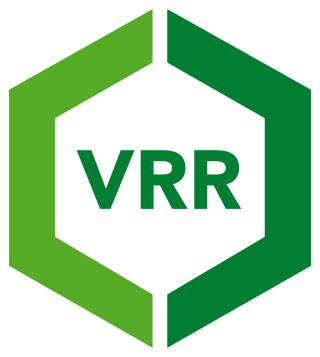
The Verkehrsverbund Rhein-Ruhr, abbreviated VRR, is a public transport association (Verkehrsverbund) in the German state of North Rhine-Westphalia. It covers most of the Ruhr area, as well as neighbouring parts of the Lower Rhine region, including Düsseldorf and thus large parts of the Rhine-Ruhr conurbation. It was founded on 1 January 1980, and is Europe’s largest body of such kind, covering an area of some 5,000 km2 (1,900 sq mi) with more than 7.8 million inhabitants, spanning as far as Dorsten in the north, Dortmund in the east, Langenfeld in the south, and Mönchengladbach and the Dutch border in the west.

The Class 420 is a commuter electric multiple unit train type in service on German S-Bahn networks since 1972. Their use in Munich during the 1972 Summer Olympics earned them the colloquial name Olympiatriebwagen.

The S28 Regiobahn is a S-Bahn line in the Rhine-Ruhr S-Bahn network. It is operated by Transdev Rheinland GmbH as a subcontractor of Regiobahn Fahrbetriebsgesellschaft mbH, who is the PSO operator on behalf of Verkehrsverbund Rhein-Ruhr (VRR).

Line S7 is an S-Bahn service on the Rhine-Ruhr network in the German state of North Rhine-Westphalia, between Wuppertal and Solingen. The line has been operated by RheinRuhrBahn since 10 December 2023 at 20-minute intervals, using Alstom Coradia LINT 41 diesel multiple unit vehicles.
Abellio Deutschland is a public transit operator in Germany operating bus and rail networks. Headquartered in Berlin, it is a subsidiary of the Dutch state-owned Abellio.

Köln-Mülheim is a railway station situated at Mülheim, Cologne in western Germany. It is served by several regional trains, the S6 and S11 lines of the Rhine-Ruhr S-Bahn and the 13 and 18 lines of Cologne Stadtbahn.

The Sieg Railway (German: Siegstrecke is a 100-kilometre long, electrified German main line railway between Cologne-Deutz via Porz, Troisdorf, Siegburg, Hennef, Au, Betzdorf to Siegen with a through service to Cologne Hauptbahnhof. Although most of it is two-track, two five-kilometre sections are only single track. Both ends of the line are in the state of North Rhine-Westphalia, but between Au and Niederschelden it runs through Rhineland-Palatinate. It is one of the oldest lines in Germany, opened between 1859 and 1862 by the Cologne-Minden Railway Company.

The Regiobahn is the operator of the S28 line of the Rhine-Ruhr S-Bahn between Kaarst, Düsseldorf, Mettmann and Wuppertal and the RE 47 between Düsseldorf and Remscheid-Lennep in the state of North Rhine-Westphalia, Germany.

The Rhein-Express is a Regional-Express service, which generally follows the Rhine river. It runs daily every hour from 5 am to 9 pm from Wesel via Oberhausen, Duisburg, Düsseldorf, Cologne, Bonn, Remagen and Andernach to Koblenz, in the German states of North Rhine-Westphalia and Rhineland-Palatinate. It is the fourth-most used regional express line in the VRR network with approximately 48,000 passengers a day.
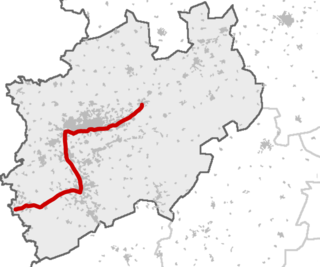
The NRW-Express is a Regional-Express rail service in the German state of North Rhine-Westphalia (NRW), running from Aachen via Cologne, Düsseldorf, Duisburg, Essen, Bochum and Dortmund to Hamm as line RE 1. The line is part of the Rhine-Ruhr Express (RRX) network and is operated by National Express.
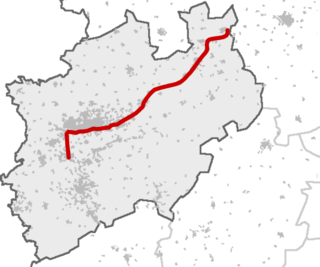
The Rhein Weser Express is a Regional-Express service route in the German state of North Rhine-Westphalia, connecting some of the most important cities in Westphalia with the Ruhr. Cologne, Neuss, Düsseldorf and Duisburg lie on the Rhine while Minden lies on the Weser.

The Rhein-Münsterland-Express is a Regional-Express service in the German state of North Rhine-Westphalia (NRW). The hourly service initially runs to the south east from Krefeld via Neuss to Cologne and then turns to run to the northeast via Solingen, Wuppertal, Hagen to Münster. Every two hours it continues to Rheine.

The Wupper-Express is a Regional-Express service in the German state of North Rhine-Westphalia (NRW) running between Aachen and Dortmund via Mönchengladbach, Düsseldorf, Wuppertal and Hagen. It is the third most widely used Regional-Express line in the area administered by the Verkehrsverbund Rhein-Ruhr (VRR) with approximately 24,000 passengers a day. The line is part of the Rhein-Ruhr-Express (RRX) network and is operated by National Express Germany.
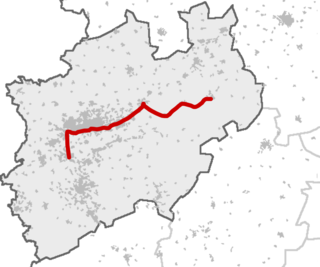
The Rhein-Hellweg-Express is a Regional-Express service in the German state of North Rhine-Westphalia (NRW), running from Kassel via Dortmund, Bochum, Essen, Duisburg and Düsseldorf Airport to Düsseldorf Hbf. It is named after the Rhine and the Westphalian Hellweg. The line is part of the Rhine-Ruhr Express (RRX) network and is operated by National Express.

The Rhein-Haard-Express is a Regional-Express service in the German state of North Rhine-Westphalia (NRW), running from Osnabrück via Münster, Recklinghausen, Gelsenkirchen, Essen and Duisburg to Düsseldorf.
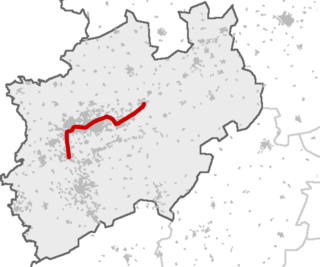
The Rhein-Emscher-Express is a Regional-Express service in the German state of North Rhine-Westphalia (NRW), running from Düsseldorf via Duisburg, Gelsenkirchen and Dortmund to Hamm. It connects with the rest of the regional rail network of NRW in Düsseldorf, Duisburg, Oberhausen, Wanne-Eickel, Dortmund and Hamm. In addition, it connects in Düsseldorf, Duisburg, Oberhausen, Dortmund and Hamm with long-distance services.

The Class 430 EMU is an electric railcar for S-Bahn commuter networks in Germany, jointly developed by Bombardier and Alstom. The first trains went into service in 2012, replacing the Class 420 EMUs of the Stuttgart S-Bahn.

The Ruhr-Lenne-Express is a Regional-Express service in the German state of North Rhine-Westphalia, running from Essen via Bochum, Witten, Bochum, Hagen and Iserlohn-Letmathe to Iserlohn. It is operated by VIAS Rail hourly.

National Express Germany is a railway operator in Germany. It is a wholly-owned subsidiary of the British transport company Mobico Group.


























